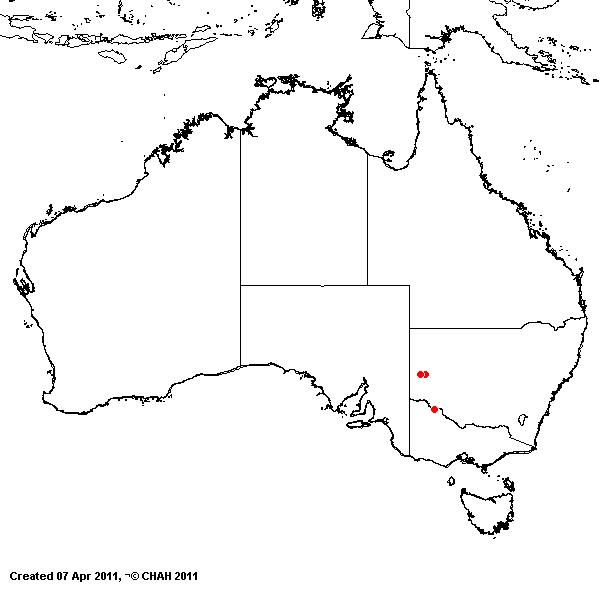Aristida vickeryae B.K.Simon. Austrobaileya
2: 94 (1984).
Classification. (GPWG 2001) : Subfamily
Aristidoideae. Aristideae.
Type of Basionym or
Protologue Information: Australia: New South Wales: South Far Western
Plains: between Euston and Gol Gol, 15 Oct. 1949, J. W. Vickery (HT:
NSW-144387; IT: BRI).
Key references
(books and floras): [2002] D.Sharp & B.K.Simon, AusGrass, Grasses of
Australia, [2008] S.W.L.Jacobs, R.D.B.Walley & D.J.B.Wheeler, Grasses
of New South Wales (132).
Illustrations:
[2008] S.W.L.Jacobs, R.D.B.Whalley & D.J.B.Wheeler, Grasses of New South
Wales, 4th edn (132).
Derivation: L.
-ana, indicating connection. In honor of Joyce Winifred Vickery
(1908–1979) Australian botanist.
Habit.
Perennial. Culms 20–45 cm tall, 2–4 -noded. Mid-culm internodes glabrous.
Lateral branches sparsely branched or branched. Ligule a fringe of hairs,
0.3–0.7 mm long. Leaf-blades flexuous, filiform, conduplicate or involute or
convolute, 4–16 cm long, 0.5 mm wide. Leaf-blade surface scabrous.
Inflorescence.
Inflorescence compound, a panicle. Panicle elliptic, effuse, 12–15 cm long, 3–5
cm wide.
Spikelets.
Spikelets pedicelled. Fertile spikelets 1-flowered, comprising 1 fertile
floret(s), without rachilla extension, lanceolate, terete, 12–13 mm long.
Glumes.
Glumes similar, thinner than fertile lemma. Lower glume lanceolate, membranous,
keeled, 1-keeled, 1 -nerved. Lower glume surface glabrous. Lower glume apex
muticous. Upper glume lanceolate, 12–13 mm long, membranous, keeled, 1-keeled,
1 -nerved. Upper glume apex entire, mucronate.
Florets.
Fertile lemma 10 mm long, without keel, 3 -nerved. Lemma apex awned, 3 -awned.
Median (principal) awn without a column. Lateral lemma awns present. Palea
without keels. Anthers 3.
Continental
Distribution: Australasia.
Australian
Distribution: New South Wales.
New South Wales:
North Far Western Plains, South Far Western Plains.
Notes.
A. vickeryae is distinguished from related species (A. leptopoda,
A. obscura and A. behriana) by the panicle which is about twice
as long as wide. The spikelets differ from A. ramosa by having larger
glumes and by the lemma being shorter than the upper glume.
Restricted
to the Murray River area of south-western New South Wales near Euston.
Flowering and fruiting October.

![[Spikelet (line drawing) © Simon 1992 by Will Smith]](/files/Vick.gif)
